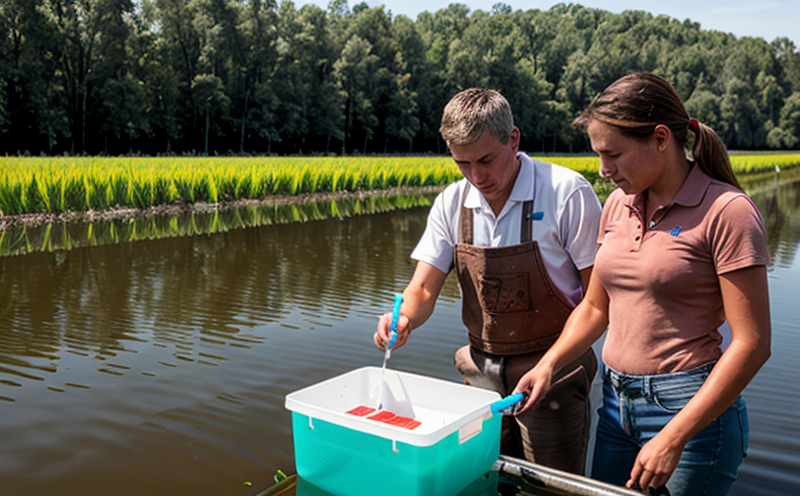Cobalt Content Testing in Agricultural Water
In agriculture and forestry testing, water quality is a critical factor that can influence plant growth, crop yield, and overall agricultural productivity. Cobalt content testing in agricultural water plays an important role in ensuring the health of plants and soil microorganisms by identifying potential risks associated with excessive cobalt concentrations.
Cobalt is an essential micronutrient for many plants but it becomes toxic at high levels. Excessive cobalt can lead to stunted growth, leaf chlorosis (yellowing), and even death in certain crops. In the context of agriculture, understanding cobalt content helps farmers make informed decisions about irrigation practices, soil amendments, and water management strategies.
Water quality testing for cobalt is essential for compliance with environmental regulations aimed at protecting both natural ecosystems and agricultural productivity. International standards such as ISO 17025 provide guidelines for laboratories performing environmental analyses. Compliance ensures that the results obtained are accurate and reliable.
The testing process involves collecting water samples from various sources, including irrigation systems, surface water bodies, and groundwater wells. Once collected, these samples undergo rigorous preparation steps before analysis can begin. Specimen preparation typically includes filtration to remove particulate matter followed by dilution if necessary.
Instrumentation used for cobalt content testing includes atomic absorption spectrophotometers (AAS) or inductively coupled plasma mass spectrometers (ICP-MS). These instruments allow precise measurement of trace elements like cobalt. The methodology adheres strictly to internationally recognized standards such as ISO 17025 and ASTM D3249.
Acceptance criteria for cobalt content tests vary depending on the intended use of the water source. For example, irrigation waters may have different permissible limits compared to drinking water supplies due to their distinct purposes. Understanding these differences allows laboratories like ours to provide accurate results tailored specifically to your needs.
The importance of cobalt content testing extends beyond just agricultural applications; it also has implications for environmental conservation efforts aimed at maintaining healthy soil and aquatic ecosystems. By monitoring cobalt levels in agricultural waters, we contribute towards preserving biodiversity and sustainable land use practices.
- Reduces risk of plant toxicity
- Promotes healthier crop yields
- Supports compliance with regulatory requirements
- Enhances overall environmental sustainability through informed decision-making
In conclusion, cobalt content testing in agricultural water is a crucial aspect of ensuring quality and safety in irrigation practices. By adhering to strict methodologies and using advanced instrumentation, we can provide reliable results that inform better management decisions for farmers and landowners alike.
Why It Matters
The importance of cobalt content testing in agricultural water cannot be overstated. This test is vital because it helps prevent potential harm to crops and soil microorganisms caused by excessive cobalt levels.
Cobalt, though beneficial at low concentrations, becomes toxic when present in high amounts. High cobalt levels can lead to various issues including reduced plant growth rates, increased susceptibility to diseases, lower seed quality, and even death in some plants. Understanding these effects is crucial for maintaining healthy agricultural ecosystems.
Water quality testing also supports compliance with regulatory frameworks designed to protect both natural environments and cultivated lands against harmful contaminants. For instance, the European Union’s Water Framework Directive sets stringent guidelines for water quality assessment across member states. Adherence to such standards ensures that agricultural activities do not contribute negatively to environmental degradation.
In addition to its role in safeguarding crops and ecosystems, cobalt content testing contributes significantly to sustainable farming practices. Farmers who conduct regular tests can adjust their irrigation methods or modify soil amendments based on accurate data about cobalt presence in water sources. This approach fosters long-term sustainability by promoting efficient resource utilization while minimizing adverse impacts on the environment.
From an economic perspective, ensuring good water quality through proper testing minimizes losses due to crop failure and enhances profitability for farmers. It also promotes better relationships between agricultural enterprises and local communities by reducing conflicts over resource usage.
Scope and Methodology
The scope of cobalt content testing in agricultural water includes the examination of various parameters related to cobalt levels within irrigation systems, surface water bodies, and groundwater wells used for agricultural purposes. This service focuses on providing accurate measurements that are essential for making informed decisions regarding water management strategies.
For specimen preparation, it involves collecting samples from different points along the supply chain to ensure comprehensive coverage of potential variations in cobalt concentrations. Sample collection should follow strict protocols outlined by relevant standards such as ISO 17025 and ASTM D3249.
The actual testing process utilizes advanced instrumentation like atomic absorption spectrophotometers (AAS) or inductively coupled plasma mass spectrometers (ICP-MS). These tools enable precise quantification of trace elements including cobalt. The analytical methods employed must comply with internationally recognized standards to guarantee the accuracy and reliability of results.
Acceptance criteria for cobalt content tests depend on specific application scenarios. For instance, irrigation water might have different permissible limits than drinking water supplies due to their distinct purposes. Compliance with these criteria ensures that agricultural activities do not pose risks either to human health or environmental integrity.
Environmental and Sustainability Contributions
Cobalt content testing in agricultural water contributes significantly to environmental conservation efforts aimed at maintaining healthy soil and aquatic ecosystems. By monitoring cobalt levels, we help prevent pollution of surface waters and groundwater resources, which are vital for sustaining diverse plant and animal life.
- Reduces contamination of rivers, lakes, and aquifers
- Promotes biodiversity by protecting native flora and fauna habitats
- Supports sustainable land use practices through informed decision-making
- Encourages efficient water resource management within agricultural settings
- Aids in mitigating the impacts of climate change by preserving soil health and fertility
- Fosters community engagement around responsible environmental stewardship initiatives
- Contributes to global efforts towards achieving United Nations Sustainable Development Goals related to agriculture, forestry, and water resources management
In summary, cobalt content testing in agricultural water is not just about ensuring quality and safety; it’s also a key component of broader sustainability strategies that benefit both present and future generations.





